THE WORLD BIRDS - An Online Bird Book
CORVIDAE
Subfamily Cissinae - Magpies
CORVIDAE
The Corvidae family contains the crows, ravens, rooks, jackdaws, jays, magpies, treepies, choughs and nutcrackers. These species are grouped into subfamilies that are outlined in the table that follows. Beware that names such as jays, magpies, or treepies are not always assigned in a consistant manner. For example, the black magpie (Platysmurus leucopterus) belongs to the treepie subfamily.
| SUBFAMILY | MEMBERS |
| Corvinae | True crows of genus Corvus includes the crows, ravens, rooks, jackdaws. |
| Corvinae (continued) | Jays of genus Garrulus, nutcrackers of Nucifraga, magpies of Pica, ground-jays of Jay Podoces, and the piapiac of Ptilostomus, and Stresemann's bush-crow of Zavattariornis. |
| Cissinae | Green-magpies of Cissa and the blue-magpies of Urocissa. |
| Cyanocoracinae | Most of the species that are named "jay". |
| Crypsirininae | Treepies |
| Perisoreinae | Three jay species of Perisoreus and Magpies of Cyanopica |
Corvids are medium to large in size, with strong feet and bills, and a single moult each year (most passerines moult twice). Most species have bristle-like feathers covering their nostrils. They are omnivores having a varied diet of animal and plant material. Makes average slightly heavier than females. Corvids are found worldwide except for the tip of South America and the polar ice caps.
Subfamily Cissinae - Magpies
This covid subfamily contains two magpie genera: the green-magpies of Cissa and the blue-magpies of Urocissa. These are Asian magpies with the greens being centered around Southeast Asia and the blues averaging more northern in location. Both magpie groups eat more vertebrates and invertebrates than plant material.
Other magpie not in this subfamily are in genus Cyanopica and genus Pica.
Genus Cissa
The green plumage of these 4 species comes from the pigment lutein, which will fade to blue if the bird has an insufficient diet, and also if it is in too bright sunlight for long. They all have mainly green plumage, a greenish-yellow crown, and a black mask that wraps around the back of its head. They also have red bills, legs, and eye-rings. The green-magpies are found in Southeast Asis, Indonesia, and Malaysia. The Indochinese green-magpie is also found in southeast China.
Magpie,_Bornean_Green- also Short-tailed Magpie Cissa jefferyi
Description: The Bornean green-magpie, also known as the short-tailed magpie, has mainly green plumage, a black mask, pink bill, and pink legs. It builds an open cup nest of sticks in the canopy. The Bornean green magpie has a rather harsh call. It is 33 cm in length.
Of the Cissa green-magpies, only the Bornean green-magpie has white eyes.
Range: Borneo.
Habitat: Thick vegetation in the mid and upper storeys of forestsl It makes only short flights.
Diet: Snails, insects, larvae.
Conservation status: Least Concern.
Image by: 1, 2) Hiyashi_H.also known as 3) Mike Price Range: Borneo.
Habitat: Thick vegetation in the mid and upper storeys of forestsl It makes only short flights.
Diet: Snails, insects, larvae.
Conservation status: Least Concern.


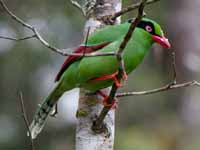
Magpie,_Common_Green- Cissa chinensis
Description: The common green-magpie has mainly green plumage (which often fades to turquoise in captivity), a yellow crown and forehead, a broad black stripe from the bill through the eye to the nape, and a long white-tipped tail. It has red-rimmed eyes, red bill, and red legs. It is 37 to 39 cm long and about 125 grams. The voice is quite varied but often a harsh peep-peep. It also frequently whistles and chatters.
Range: India to southeast Asia, Malaysia.
Habitat: Evergreen forests, bamboo, clearings, scrub.
Diet: Insects, small reptiles, mammals and young birds and eggs.
Conservation status: Least Concern.
Image by: 1) David Jarvis - Thailand zoo 2) Jason_Thompson - Thailand 3) BudakRange: India to southeast Asia, Malaysia.
Habitat: Evergreen forests, bamboo, clearings, scrub.
Diet: Insects, small reptiles, mammals and young birds and eggs.
Conservation status: Least Concern.


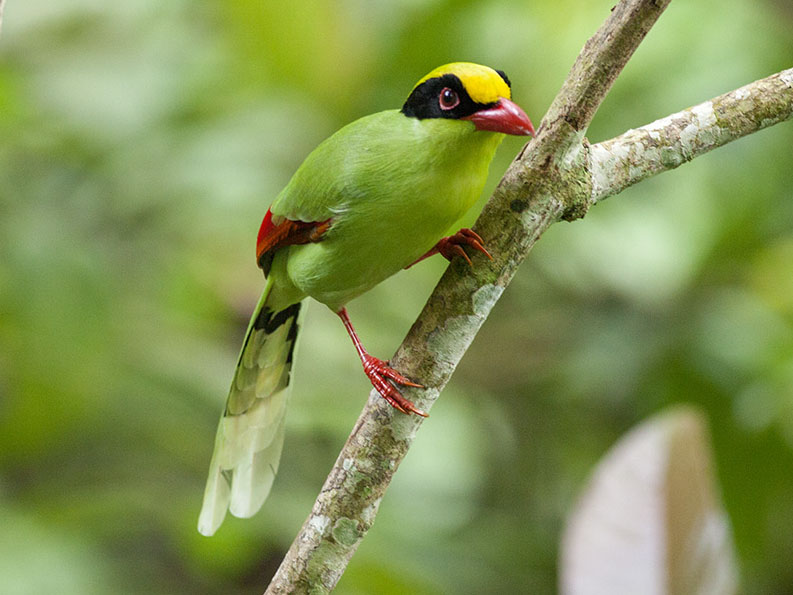
Magpie,_Indochinese Green- Cissa hypoleuca
Description: The Indochinese green-magpie, also known as the yellow-breasted magpie, has a green mantle, shoulders, crown extending to the forehead, and tail. It has a black mask which extends to the back of the head. The bill, eye-rings, and tail are red. The breast is yellow with the belly paler. It is 34 to 35 cm long and weighs about 125 grams.
Range: Southeast Asia and adjacent China.
Habitat: Evergreen forests, bamboo.
Diet: Insects, small reptiles, mammals and young birds and eggs.
Conservation status: Least Concern.
Image by:
1) Quarti Range: Southeast Asia and adjacent China.
Habitat: Evergreen forests, bamboo.
Diet: Insects, small reptiles, mammals and young birds and eggs.
Conservation status: Least Concern.

Magpie,_Javan Green- Cissa thalassina
Description: The Javan green-magpie has a mainly green plumage.There is a yellow crown and forehead. It has a black mask which extends to the back of the head. The bill, eye-rings, and tail are red. The underparts are yellowish green. It is 31 cm long,which is shorter than the other genus members because of its shorter tail,
and weighs about 125 grams. The Bornean green magpie was formerly considered as a subspecies, in which case the "combined" species was known as the short-tailed magpie.
Range: Java (Indonesia).
Habitat: Rainforests; also captive breeding programs.
Diet: Insects, lizards, frogs.
Conservation status: It is listed as Critically Endangered. Perhaps the entire population is now in captivity.
Image by:
1) PaleoMatt 2) Vaclav_Silhaand weighs about 125 grams. The Bornean green magpie was formerly considered as a subspecies, in which case the "combined" species was known as the short-tailed magpie.
Range: Java (Indonesia).
Habitat: Rainforests; also captive breeding programs.
Diet: Insects, lizards, frogs.
Conservation status: It is listed as Critically Endangered. Perhaps the entire population is now in captivity.


Genus Urocissa
The majority of these 5 blue-magpies species have mainly blue upperparts, a black hood, and a very long graduated tail. For the Sri Lanka blue-magpie the black is replace by chestnut. The white-winged magpie is an exception, it has mainly black and white plumage; perhaps it should not be in this genus. The blue-magpies are found in the Indian subcontinent, southern China, Taiwan, Vietnam and nearby countries.
Magpie,_Red-billed Blue- Urocissa erythrorhyncha
Description: The red-billed blue-magpie has a black head, neck, and breast. It has bluish spots on the crown. The rump and shoulders are dull blue while the white-tipped tail is bluer. The underparts are greyish-cream colored. It has an orange-red bill, eye-ring, and legs. Because of its very long tail it is 65 to 68 cm long which makes it one of the longest covids. It weighs about 210 grams. The similar gold-billed magpie does not have blue spots on its crown.
Range: Indian subcontinent, Vietnam and nearby countries.
Habitat: Evergreen forest and scrub in predominantly hilly or mountainous country.
Diet: Invertebrates, fruit, seeds, chick, eggs. Also small mammals.
Conservation status: Least Concern.
Image by: 1) Nagesh Kamath - India 2) Tom Coleman - Washington National Zoo 3) David Cook - Cambodia 4) Charles Lam - Hong Kong Range: Indian subcontinent, Vietnam and nearby countries.
Habitat: Evergreen forest and scrub in predominantly hilly or mountainous country.
Diet: Invertebrates, fruit, seeds, chick, eggs. Also small mammals.
Conservation status: Least Concern.
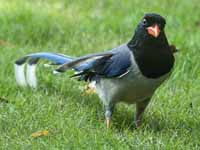


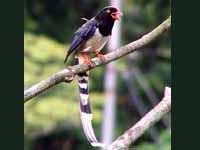
Magpie,_Sri Lanka Blue- Urocissa ornata
Description: The Sri Lanka blue-magpie has mainly blue plumage. The head, wings, and upper-breast are chestnut. It produces a great variety of vocalizations, including a jingle, a chink-chink, crakrakrakrak, and a whee-whee. The Sri Lanka blue-magpie also mimic sounds of predators and other birds. It is 40 to 47 cm long.
Range: Sri Lanka.
Habitat: Tall, undisturbed forest.
Diet: Mainly carnivorous, featuring insects, caterpillars, frogs, and small lizards. Also fruit.
Conservation status: The Sri Lanka blue-magpie is listed as Vulnerable because of fragmentation of its range and destruction of primary forest.
Image by: 1)Timindu 2, 3) Gaurika Wijeratne 4) Koshy_KoshyRange: Sri Lanka.
Habitat: Tall, undisturbed forest.
Diet: Mainly carnivorous, featuring insects, caterpillars, frogs, and small lizards. Also fruit.
Conservation status: The Sri Lanka blue-magpie is listed as Vulnerable because of fragmentation of its range and destruction of primary forest.


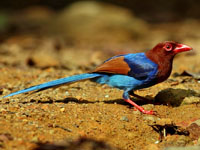

Magpie,_Taiwan Blue Urocissa caerulea
Description: The Taiwan blue-magpie has a black head, neck, and breast. It has a dark blue to purple back, belly, and upper-tail. The central pair of tail feathers are the longest. The eyes are yellow while the bill and legs are red. It is 63 to 68 cm long and weighs about 250 grams. Incubation takes about two and a half weeks; fledging about another three. They are cooperative breeds; helpers contribute feeding the chicks and defending the nest.
Range: Taiwan.
Habitat: Broadleaf forests. They are not very afraid of humans and may eat human gabage and handouts.
Diet: Snakes, rodents, small insects, carrion, eggs and chicks of other birds, plants, fruits, and seeds.
Conservation status: Least Concern.
Image by: 1) Lai Wagtail 2) Francesco Veronesi -
Yangmingshan, Taiwan 3) Lin_Sun_Fong 4) jennyhsu47Range: Taiwan.
Habitat: Broadleaf forests. They are not very afraid of humans and may eat human gabage and handouts.
Diet: Snakes, rodents, small insects, carrion, eggs and chicks of other birds, plants, fruits, and seeds.
Conservation status: Least Concern.
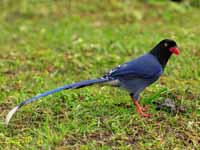



Magpie,_White-winged Urocissa whiteheadi
Description: The white-winged magpie has mainly black and white plumage. The rump and under tail are yellow. It has an orange bill and black legs. Since it lacks the blue plumage of other Urocissa magpies, there have been suggestions to use a separate genus. It is about 43 cm long and 200 grams in weight.
Range: Southern China, Laos, northern Vietnam.
Habitat: Evergreen and mixed forests. Also secondary forests.
Diet: Information needed.
Conservation status: The white-winged magpie is listed as Endangered as it is rarely encountered. It is believed to have a diminishing population due to habitat destruction.
Image by: 1) Henrik_GronvoldRange: Southern China, Laos, northern Vietnam.
Habitat: Evergreen and mixed forests. Also secondary forests.
Diet: Information needed.
Conservation status: The white-winged magpie is listed as Endangered as it is rarely encountered. It is believed to have a diminishing population due to habitat destruction.

Magpie,_Yellow-billed Blue- also Gold-billed Magpie Urocissa flavirostris
Description: The yellow-billed blue-magpie, also known as the gold-billed magpie, has purplish-blue upperparts plus a very long and graduated tail that is blue with white tips. The head, neck, and upper-breast are black. The remainder of the underparts are white. It has golden-yellow bill. The yellow-billed blue-magpie is 66 cm long, of which about 46 cm is the tail.
It is very noisy; the ordinary call is harsh and grating, but it has a wide variety of notes.
The similar red-billed blue-magpie has blue spots on its crown.
Range: The Himilayas of northern India and adjacent countries.
Habitat: Jungles to the bare sides of mountains.
Diet: Insects, lizards, amphibians, eggs, chicks. Also fruit.
Conservation status: Least Concern.
Image by: 1) Imran_Shah - Pakistan 2) Dibyendu Ash - India 3) Shrikant_Rao - India 4)Lip KeeRange: The Himilayas of northern India and adjacent countries.
Habitat: Jungles to the bare sides of mountains.
Diet: Insects, lizards, amphibians, eggs, chicks. Also fruit.
Conservation status: Least Concern.




